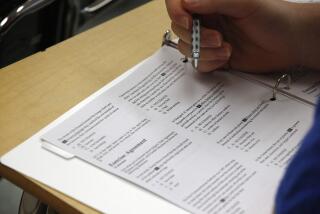SAT Alternative Also Opens Doors to University Admission
- Share via
Almost any college-bound student will tell you that the Scholastic Aptitude Test (SAT) is the most feared step in the college admission process.
But the SAT is only one of two aptitude tests accepted by colleges and universities. The alternative is the American College Test (ACT). It is used primarily in the Midwest and South, but is slowly winning fans among college admissions counselors in California.
At most California high schools, 10 or 20 times as many students take the SAT as take the ACT, but college-bound students should still take note that the ACT is a genuine option. It is accepted by most colleges and universities, including all Cal State and UC schools.
On the surface, the two tests seem similar. Both are widely believed to help predict a student’s chances of success in college. Both are offered several times a year and are usually taken in the junior or senior year. And both last three hours and ask about the same number of questions.
There are, however, significant differences. Most important, the skills measured by these tests are different. While the SAT emphasizes basic aptitude and “creative” thinking, the ACT is based more on the skills and content learned in school.
“They’re measuring different things,” said Mark Black, a testing consultant to some local schools. “The ACT measures what the kid has done in school, whereas (the SAT) is more a measure of their aptitude to do college-level work and to get a certain GPA in a particular college,” he said.
The tests’ formats differ, too. While the SAT is divided into two sections, verbal and math, the ACT has four sections, which touch on many more content areas.
In the English Test, you will read five passages on a variety of topics, then answer 75 multiple-choice questions that measure skills in standard written English, such as grammar, punctuation, and sentence structure.
The Math Test consists of 60 multiple-choice problems in content areas that college-bound students usually take before 12th grade: pre-algebra, elementary algebra, intermediate algebra and coordinate geometry, plane geometry, and trigonometry.
The Reading Test contains four prose passages drawn from sources that include fiction, natural science, humanities, and social studies. Each passage is followed by a group of multiple-choice items (40 in all) that ask you to cite surface and implicit meanings, and to draw conclusions, comparisons, and generalizations.
The vocabulary portion of the Reading Test also differs sharply from that on the SAT and may be more manageable because the words are presented in context, rather than in isolation as on the SAT. So if you don’t recognize the word, you can at least analyze its use within the passage for clues to its meaning.
The Science Reasoning Test asks 40 multiple-choice questions that gauge skills used in the natural sciences, including interpretation, evaluation, and reasoning. Some questions may draw on scientific knowledge that you should have learned in high school, but most questions ask about information in the accompanying graphs, tables, and passages.
Scoring is another difference between the ACT and SAT. The SAT point system ranges from 400 to 1,600. The ACT score ranges from 10 to 36.
The percentage of students who choose the ACT varies greatly from school to school in California, and seems to depend mostly on whether college counselors at the school push it as an option. But generally, the trend is upward.
“We’ve really increased the number of students taking it,” said Janis Marcy, a college counselor at Santa Monica High School. “So far this year we’ve had over 150 kids take it, which I think is terrific.”
“It’s being accepted (by students) more and more on the West Coast,” said Charles Diggs, a college counselor at Palisades High School. “I think it’s a wave coming this way.”
Students may be taking a second look at the ACT because “it’s more subject-oriented,” said Esther Hugo, a college counselor at Westchester High School. “Students find that it’s closer to what they encounter during the regular school day.
“Students who are verbally inclined may do better on it,” Hugo added, “because there’s not as much math” as on the SAT.
If you can’t choose between the ACT and SAT, there’s no harm in taking both and letting the college decide which score to emphasize. When colleges and universities accept both tests, they will disregard the lesser score.
“We accept either one equally,” explained Rae Lee Siporin, director of undergraduate admissions at UCLA. “We’ll look at both (test scores) and use whichever is best.”
To find out more about the ACT, including spring test dates, ask your college counselor for an information packet, which will include a registration form and sample tests.
More to Read
Sign up for Essential California
The most important California stories and recommendations in your inbox every morning.
You may occasionally receive promotional content from the Los Angeles Times.













